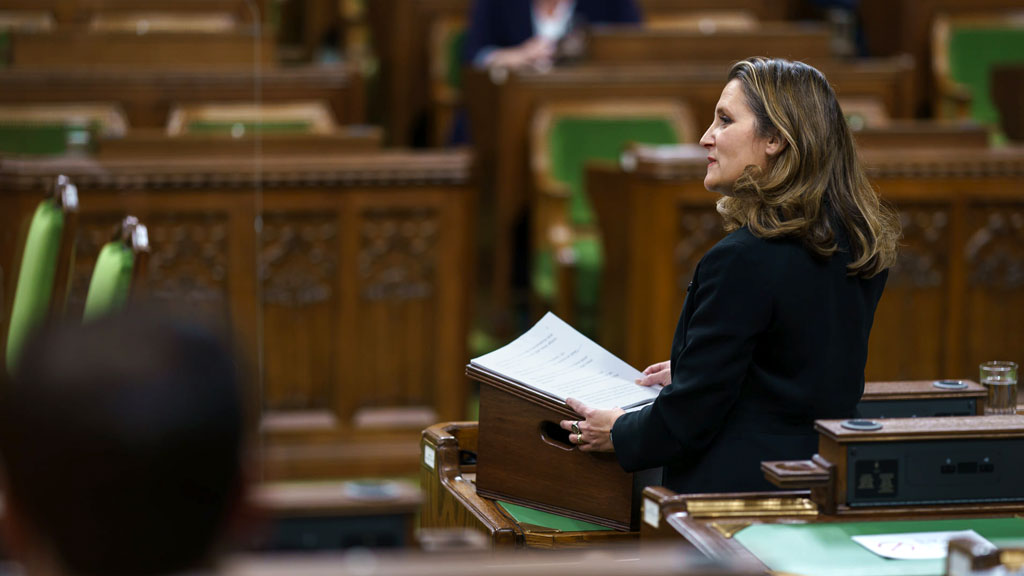Canada’s builders will have to wait until spring for new federal infrastructure spending to stimulate economic recovery.
Minister of Finance Chrystia Freeland said Nov. 30 the federal government will take a two-phased approach to fighting the pandemic-induced recession, first taking steps over the winter to control the spread of COVID-19 while continuing to offer income supports, then next spring launching a stimulus package that will include infrastructure spending.
Delivering her first economic update, Freeland said the government will spend between $70 billion and $100 billion to stimulate the economy, budgeted over the three fiscal years starting next April 1.
“This stimulus will help accelerate our economic recovery and will be deployed at a time when the virus is under control and the economy is able to effectively absorb it,” Freeland’s budget document stated.
“The stimulus will help us build out of this recession towards an economy that is greener, more innovative, more inclusive and more competitive.”
Infrastructure that supports communities
The stimulus spending package, which Freeland said would be developed in consultation with Canadians in the coming months, will promote a green economy, support infrastructure that boosts communities, workers and flow of goods, and promote inclusive participation in the workforce.
“The heart of this stimulus plan will be smart, time-limited investments that can act fast to jumpstart the recovery and have long-run value by creating shared prosperity, improving Canadians’ quality of life and powering our green transformation,” stated the update.
The projected size of this year’s deficit has jumped to $381.6 billion, up from the $343.2 billion forecast in early July. And Freeland said the deficit could rise if the pandemic causes further shuttering of the economy.
Freeland told CBC Radio the government plans to combat its deficit through growth.
“I believe the best strategy for paying down our debt is strong economic growth,” she said. “The best way to have healthy finances is to grow, and that is what we are going to do with the Canadian economy.
“Our interest charges are lower than they have been in 100 years. That should reassure a lot of people. That is prudent management, that is good news.”
Employment is not projected to return to pre-pandemic levels until August 2022. The government says its goal is to create one million jobs as part of an accelerated recovery path.
Positioning for recovery
Freeland, successor in the finance job to Bill Morneau, who resigned in August, said the government will continue to spend heavily on programs like the Canada Emergency Response Benefit, the Canada Emergency Wage Subsidy and tailored liquidity, credit and financing support for businesses to “stave off mortgage defaults, business closures and other forms of long-term economic scarring as it rides out phase two of the pandemic.”
“These programs are also working well to put Canada in a stronger position for a robust recovery,” the updates states.
Spending up to $100 billion over the next three fiscal years amounts to between three to four per cent of GDP, more than the 2.5 per cent of GDP spent to stimulate the economy in 2008-09 by Canada.
“These measures will help the economy grow, become more productive and help Canada build back better, greener and more resilient,” stated the update. “This strong growth plan can turn a partial and uneven recovery into a broad-based and inclusive recovery from which we will all benefit.”
Freeland also announced that the government would take steps to return immigration back to pre-pandemic levels as another way to boost the economy. In 2019, Canada admitted 341,175 permanent residents but in the first nine months of 2020, only 143,470 permanent residents arrived in Canada. The government said it will also increase support for its Foreign Credential Recognition Program by $15 million in an effort to attract skilled newcomers to Canada’s in-demand sectors. Up to 15,000 new Canadians would benefit.
The government will also expand spending on its Rental Construction Financing Initiative. The Canada Mortgage and Housing Corporation will be given an additional $12 billion in new lending over seven years to increase the program’s total lending capacity to $25.75 billion in low-interest loans, enabling the construction of an additional 28,500 rental units.
The government said it plans to announce further details of its public transit expansion program, currently financed by the Investing in Canada Plan, in coming months. The new plan will further efforts to electrify public transit systems across Canada, and provide permanent public transit funding, in partnership with the provinces and territories.
Freeland also announced measures to accelerate spending on water infrastructure in Indigenous communities and boost support for broadband, and reiterated the government’s pledge to collaborate with the Canada Infrastructure Bank on a $10 billion Growth Plan that includes green infrastructure.
Follow the author on Twitter @DonWall_DCN.











Recent Comments
comments for this post are closed